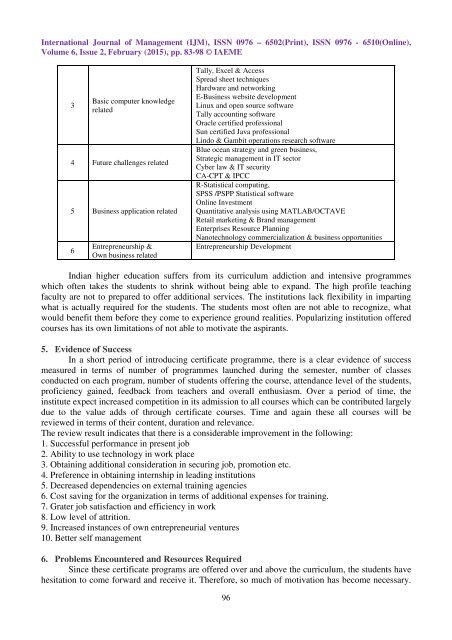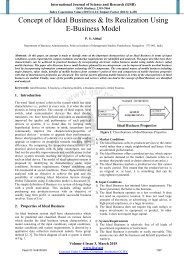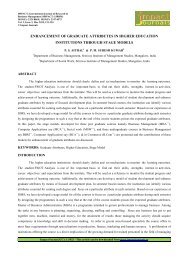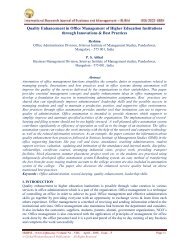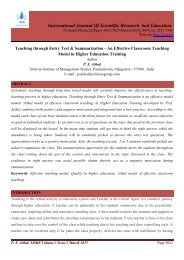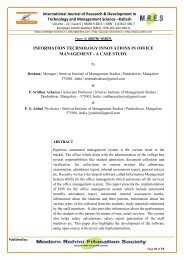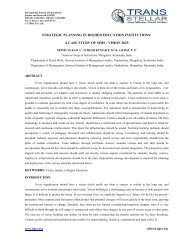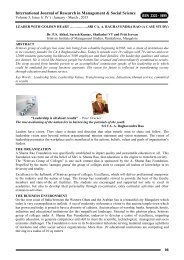How Innovations and Best Practices can Transform Higher Education Institutions : A case study of SIMS
Education has become competitive so as the educational institutions. In order to survive the competition, institutions have to improve the quality of their services. Changes in culture, aspiration and levels of skills required in securing employment for students, force higher education institutions today to rework on their educational models and add value to each and every aspect of their service. Innovations and best practices serve to enhance quality and add value. Srinivas Institute of Management Studies (SIMS), which combines technology, management and social service education has identified and implemented innovations and best practices to differentiate itself among the competitors and to add value in its educational services. In this paper, we have discussed innovations, small and big, develped indigineously and implemented during last four years. They are broadly classified under six key aspects namely "curricular aspects, teaching-learning and evaluation, research, consultancy and extension, infrastructure and learning resources, student support and progression, and governance, leadership, and management". The paper also contains some of the intitutional and individual faculty best practices having visible impact on the quality of higher education imparted by the institution. The best practices concern admission, fees, attendance, teaching, performance, skill building, employability, student involvement, collective learning, value addition, ensuring transparency, information dessimination etc. Finally two institutional best practices are elaborated with its aim of practice, underlying principles and concepts, particular contextual features or challenging issues that have had to be addressed in designing and implementing the practice, and its implementation, including its uniqueness in Indian higher education, evidence of success, identifying the problems encountered and resources required to implement the practice.
Education has become competitive so as the educational institutions. In order to survive the competition, institutions have to improve the quality of their services. Changes in culture, aspiration
and levels of skills required in securing employment for students, force higher education institutions
today to rework on their educational models and add value to each and every aspect of their service. Innovations and best practices serve to enhance quality and add value. Srinivas Institute of
Management Studies (SIMS), which combines technology, management and social service education
has identified and implemented innovations and best practices to differentiate itself among the competitors and to add value in its educational services. In this paper, we have discussed
innovations, small and big, develped indigineously and implemented during last four years. They are
broadly classified under six key aspects namely "curricular aspects, teaching-learning and evaluation, research, consultancy and extension, infrastructure and learning resources, student support and progression, and governance, leadership, and management". The paper also contains some of the
intitutional and individual faculty best practices having visible impact on the quality of higher education imparted by the institution. The best practices concern admission, fees, attendance, teaching, performance, skill building, employability, student involvement, collective learning, value
addition, ensuring transparency, information dessimination etc. Finally two institutional best practices are elaborated with its aim of practice, underlying principles and concepts, particular contextual features or challenging issues that have had to be addressed in designing and implementing the practice, and its implementation, including its uniqueness in Indian higher
education, evidence of success, identifying the problems encountered and resources required to implement the practice.
You also want an ePaper? Increase the reach of your titles
YUMPU automatically turns print PDFs into web optimized ePapers that Google loves.
International Journal <strong>of</strong> Management (IJM), ISSN 0976 – 6502(Print), ISSN 0976 - 6510(Online),<br />
Volume 6, Issue 2, February (2015), pp. 83-98 © IAEME<br />
3<br />
Basic computer knowledge<br />
related<br />
4 Future challenges related<br />
5 Business application related<br />
6<br />
Entrepreneurship &<br />
Own business related<br />
Tally, Excel & Access<br />
Spread sheet techniques<br />
Hardware <strong>and</strong> networking<br />
E-Business website development<br />
Linux <strong>and</strong> open source s<strong>of</strong>tware<br />
Tally accounting s<strong>of</strong>tware<br />
Oracle certified pr<strong>of</strong>essional<br />
Sun certified Java pr<strong>of</strong>essional<br />
Lindo & Gambit operations research s<strong>of</strong>tware<br />
Blue ocean strategy <strong>and</strong> green business,<br />
Strategic management in IT sector<br />
Cyber law & IT security<br />
CA-CPT & IPCC<br />
R-Statistical computing,<br />
SPSS /PSPP Statistical s<strong>of</strong>tware<br />
Online Investment<br />
Quantitative analysis using MATLAB/OCTAVE<br />
Retail marketing & Br<strong>and</strong> management<br />
Enterprises Resource Planning<br />
Nanotechnology commercialization & business opportunities<br />
Entrepreneurship Development<br />
Indian higher education suffers from its curriculum addiction <strong>and</strong> intensive programmes<br />
which <strong>of</strong>ten takes the students to shrink without being able to exp<strong>and</strong>. The high pr<strong>of</strong>ile teaching<br />
faculty are not to prepared to <strong>of</strong>fer additional services. The institutions lack flexibility in imparting<br />
what is actually required for the students. The students most <strong>of</strong>ten are not able to recognize, what<br />
would benefit them before they come to experience ground realities. Popularizing institution <strong>of</strong>fered<br />
courses has its own limitations <strong>of</strong> not able to motivate the aspirants.<br />
5. Evidence <strong>of</strong> Success<br />
In a short period <strong>of</strong> introducing certificate programme, there is a clear evidence <strong>of</strong> success<br />
measured in terms <strong>of</strong> number <strong>of</strong> programmes launched during the semester, number <strong>of</strong> classes<br />
conducted on each program, number <strong>of</strong> students <strong>of</strong>fering the course, attendance level <strong>of</strong> the students,<br />
pr<strong>of</strong>iciency gained, feedback from teachers <strong>and</strong> overall enthusiasm. Over a period <strong>of</strong> time, the<br />
institute expect increased competition in its admission to all courses which <strong>can</strong> be contributed largely<br />
due to the value adds <strong>of</strong> through certificate courses. Time <strong>and</strong> again these all courses will be<br />
reviewed in terms <strong>of</strong> their content, duration <strong>and</strong> relevance.<br />
The review result indicates that there is a considerable improvement in the following:<br />
1. Successful performance in present job<br />
2. Ability to use technology in work place<br />
3. Obtaining additional consideration in securing job, promotion etc.<br />
4. Preference in obtaining internship in leading institutions<br />
5. Decreased dependencies on external training agencies<br />
6. Cost saving for the organization in terms <strong>of</strong> additional expenses for training.<br />
7. Grater job satisfaction <strong>and</strong> efficiency in work<br />
8. Low level <strong>of</strong> attrition.<br />
9. Increased instances <strong>of</strong> own entrepreneurial ventures<br />
10. Better self management<br />
6. Problems Encountered <strong>and</strong> Resources Required<br />
Since these certificate programs are <strong>of</strong>fered over <strong>and</strong> above the curriculum, the students have<br />
hesitation to come forward <strong>and</strong> receive it. Therefore, so much <strong>of</strong> motivation has become necessary.<br />
96


